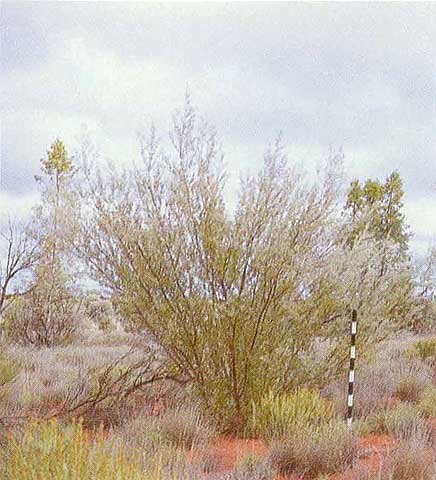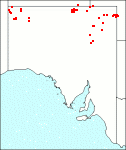Family: Fabaceae
Acacia dictyophleba

Citation:
F. Mueller, Fragm. Phyt. Aust. 3:128 (1863).
Derivation: dicktyon (Gr.)—net; phleps (Gr.)—a vein, refers to the prominent net veined phyllodes.
Synonymy: Racosperma dictyophlebum (F. Muell.) Pedley, Austrobaileya 2:347 (1987).
Common name: None
Description:
Erect, compact, spreading, glabrous, resinous shrubs 1-4 m high, sometimes rather open and straggly with a short trunk and long arching branches, foliage appearing whitish to pale green; branchlets resinous, slightly pustulate, slightly angular or ribbed; bark grey-brown, smooth on branches, rough at the base.
Phyllodes oblanceolate or more or less narrow-elliptic, 2-7 cm long, 5-15 mm broad, straight or slightly curved, coriaceous, viscid, glabrous, sometimes scurfy or pruinose, 2 (rarely 3) prominent longitudinal veins, lateral veins numerous, conspicuous, raised and anastomosing; apex obtuse but minutely mucronate; glands basal.
Inflorescences simple and axillary, solitary or twin; flower-heads globular c. peduncles 15-20 mm long viscid, glabrous; flowers 5-merous.
Legumes oblong, 5-9 cm long, 12-15 mm broad, flattish but raised over seeds; thin, light brown often with a shining varnished appearance, margins vein-like straight. Seeds transverse in legume; funicle short, folded, aril oblique, small.
|
|
Distribution:
|
Scattered in the northern part of the State from the far North-Western region, eastward to the Lake Eyre region in the Simpson Desert area. In open woodland or hummock grassland, associated with Triodia basedowii. Soils; mainly in red siliceous sands. Rainfall 125-200 mm. Also W.Aust., N.T. and Qld.
S.Aust.: LE.
|
Flowering time: April — September.
|

SA Distribution Map based
on current data relating to
specimens held in the
State Herbarium of South Australia
|
Biology:
No text
Related taxa:
Acacia montana (sp. 65) is similar in phyllode characters having 2 prominent veins with fine reticulate lateral veins, but the phyllodes are usually much shorter; and the legumes are densely covered with white-woolly hairs.
Taxonomic notes:
Acacia melleodora Pedley (1978) agrees in many respects with plants from the North-Western region identified as A. dictyophleba. Further investigation is needed to clarify the position of A. melleodora for South Australia.
Cultivation:
The large, deep yellow, globular flowers make this shrub an attractive ornamental species. Suitable for dry inland areas in open well drained position or sandy soils.
Author:
Not yet available
Source:

|

